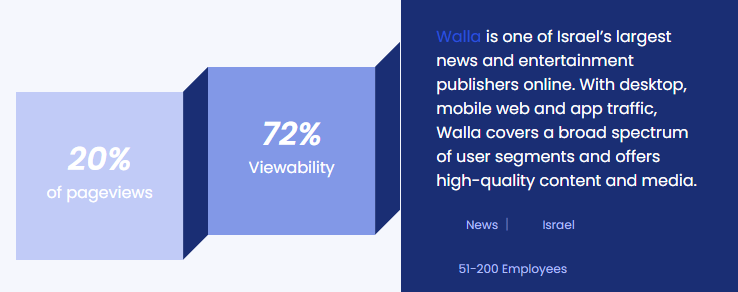Walla uses Browsi Viewability Server to create ad inventory with 72% viewability rate

Shai Klayman
Head of programmatic
“We looked at building a solution for ad layout internally, and even with a talented team and the resources to build something, Browsi was light years ahead and would alleviate the ongoing maintenance fees. The solution is cost effective and keeps us ahead of the game as industry standards change while achieving our goals. Ad layout must leverage AI – in today’s industry that’s the only way and Browsi nails it.”

With fast-growing mobile web and app traffic, Walla sought to fill the monetization gap created by a lean page layout. No easy feat, a solution would accommodate ongoing requests from advertisers for high viewability and engagement, and agility for volatile industry standards in UX and a shift toward better ads – while achieving an internal push to reduce interstitials and other intrusive ads.
Beyond the core challenge, mounting demand providers across direct, sponsored content, programmatic and other revenue sources further complicated the ability to respond and integrate to the page quickly.
After reviewing the potential to build a scalable, efficient and cost-effective solution internally, this option was ruled out as inadequate for achieving the breadth of control and ongoing maintenance needed to meet goals consistently.
Quickly integrating Browsi’s engine, Walla introduced Browsi’s smart in-line inventory to all mobile web and app article pages. Browsi’s GDPR-compliant, deep learning engine immediately began to collect and apply all relevant data to match users with the right inventory on the page – along with complete location and the appropriate number of ads per user and article as determined by the engine in conjunction with the publisher.
As a deep learning engine that opens a host of strategic levers for further optimizing inventory, Walla began to leverage Browsi supply strategies to control the number of ads per section by traffic source, thereby dynamically controlling demand source matching with far greater efficacy than relying on historical measurement data or A/B testing.
Walla’s inventory has grown by 70% with no impact to user engagement – as confirmed by Browsi and Walla reporting. This new inventory which is used mainly for programmatic has enabled Walla to allocate more resources to structural and editorial tasks rather than the ongoing challenges posed by ad layout’s moving target.
Viewability has since climbed and achieved stability at 72%. As a result, programmatic CPMs in Browsi’s smart inventory on Walla are 20% higher, with the ongoing ability to balance scale and viewability on the fly.

